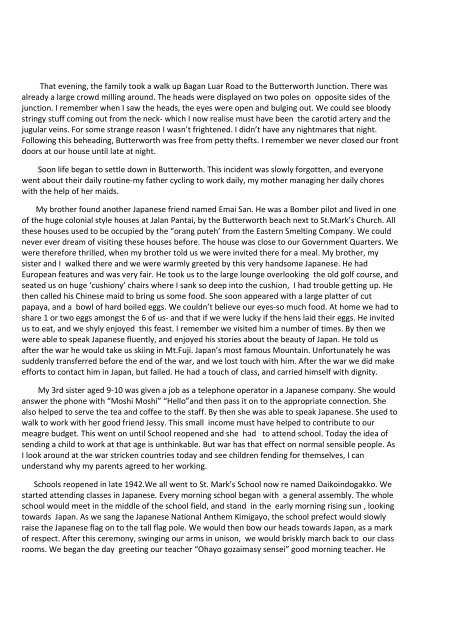Japanese Occupation- Dato' Param.pdf - Malaysian Paediatric ...
Japanese Occupation- Dato' Param.pdf - Malaysian Paediatric ...
Japanese Occupation- Dato' Param.pdf - Malaysian Paediatric ...
You also want an ePaper? Increase the reach of your titles
YUMPU automatically turns print PDFs into web optimized ePapers that Google loves.
That evening, the family took a walk up Bagan Luar Road to the Butterworth Junction. There was<br />
already a large crowd milling around. The heads were displayed on two poles on opposite sides of the<br />
junction. I remember when I saw the heads, the eyes were open and bulging out. We could see bloody<br />
stringy stuff coming out from the neck- which I now realise must have been the carotid artery and the<br />
jugular veins. For some strange reason I wasn’t frightened. I didn’t have any nightmares that night.<br />
Following this beheading, Butterworth was free from petty thefts. I remember we never closed our front<br />
doors at our house until late at night.<br />
Soon life began to settle down in Butterworth. This incident was slowly forgotten, and everyone<br />
went about their daily routine-my father cycling to work daily, my mother managing her daily chores<br />
with the help of her maids.<br />
My brother found another <strong>Japanese</strong> friend named Emai San. He was a Bomber pilot and lived in one<br />
of the huge colonial style houses at Jalan Pantai, by the Butterworth beach next to St.Mark’s Church. All<br />
these houses used to be occupied by the “orang puteh’ from the Eastern Smelting Company. We could<br />
never ever dream of visiting these houses before. The house was close to our Government Quarters. We<br />
were therefore thrilled, when my brother told us we were invited there for a meal. My brother, my<br />
sister and I walked there and we were warmly greeted by this very handsome <strong>Japanese</strong>. He had<br />
European features and was very fair. He took us to the large lounge overlooking the old golf course, and<br />
seated us on huge ‘cushiony’ chairs where I sank so deep into the cushion, I had trouble getting up. He<br />
then called his Chinese maid to bring us some food. She soon appeared with a large platter of cut<br />
papaya, and a bowl of hard boiled eggs. We couldn’t believe our eyes-so much food. At home we had to<br />
share 1 or two eggs amongst the 6 of us- and that if we were lucky if the hens laid their eggs. He invited<br />
us to eat, and we shyly enjoyed this feast. I remember we visited him a number of times. By then we<br />
were able to speak <strong>Japanese</strong> fluently, and enjoyed his stories about the beauty of Japan. He told us<br />
after the war he would take us skiing in Mt.Fuji. Japan’s most famous Mountain. Unfortunately he was<br />
suddenly transferred before the end of the war, and we lost touch with him. After the war we did make<br />
efforts to contact him in Japan, but failed. He had a touch of class, and carried himself with dignity.<br />
My 3rd sister aged 9-10 was given a job as a telephone operator in a <strong>Japanese</strong> company. She would<br />
answer the phone with “Moshi Moshi” “Hello”and then pass it on to the appropriate connection. She<br />
also helped to serve the tea and coffee to the staff. By then she was able to speak <strong>Japanese</strong>. She used to<br />
walk to work with her good friend Jessy. This small income must have helped to contribute to our<br />
meagre budget. This went on until School reopened and she had to attend school. Today the idea of<br />
sending a child to work at that age is unthinkable. But war has that effect on normal sensible people. As<br />
I look around at the war stricken countries today and see children fending for themselves, I can<br />
understand why my parents agreed to her working.<br />
Schools reopened in late 1942.We all went to St. Mark’s School now re named Daikoindogakko. We<br />
started attending classes in <strong>Japanese</strong>. Every morning school began with a general assembly. The whole<br />
school would meet in the middle of the school field, and stand in the early morning rising sun , looking<br />
towards Japan. As we sang the <strong>Japanese</strong> National Anthem Kimigayo, the school prefect would slowly<br />
raise the <strong>Japanese</strong> flag on to the tall flag pole. We would then bow our heads towards Japan, as a mark<br />
of respect. After this ceremony, swinging our arms in unison, we would briskly march back to our class<br />
rooms. We began the day greeting our teacher “Ohayo gozaimasy sensei” good morning teacher. He
















